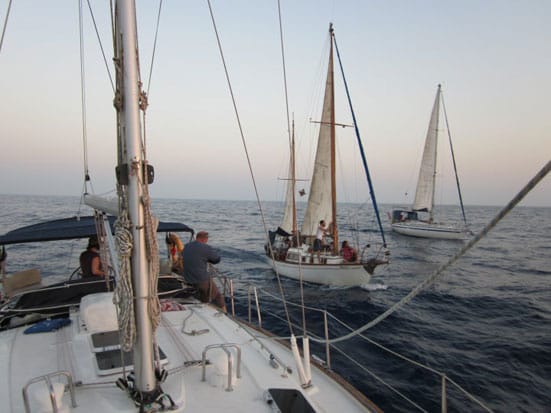Somewhere on the coast of a Mediterranean city, sometime after dark, an image appears on a sail of a floating boat. It is the figure of a woman walking on thin ground, falling, getting up, starting to walk again and falling repeatedly, failing to complete her short journey upright. The video by Constanze Vogt was screened as part of Exterritory Project's first official event that took place during June 17-21 in Mediterranean waters.
Exterritory Project was conceived by artists Ruti Sela and Maayan Amir as a platform for cultural exchange outside national territory in an attempt to form a utopian sphere for creating and exhibiting art, free from national restraints and considerations. During the five days of the event a group of over a dozen artists, curators, researchers and seamen from across the world (well, mainly the Middle East and Europe, including me) met on three boats sailing in the Mediterranean Sea to present their works and to research collaboratively the notion of exterritory in an artistic context. Dozens of other artists replied to the project's open call by sending videos which were screened during the event on the sails of the boats and on a beach facing the water.
In a workshop held by Anat Ben David on a salt lake the group discussed the conceptual side of exterritory and went over relevant or corresponding theoretical and political notions such as non-places, no man's land, buffer zones, Heterotopia. T.A.Z., etc. During the workshop we tried to extract the uniqueness of exterritory vis-à-vis these concepts and to define an alternative, experimental space for creation and discourse where the national paradigm was no longer an obstacle or a predetermining factor. Throughout the event, though conscious and sensitive to the usage of national definitions, we learned how instinctive, even inevitable it was to create an interaction free from any national inclination. The more we were sheltered from a territorial space and in continuous transit, the more inherent, automatic the bound national interpellations were crystallized and present as a second skin. Hence, for me, this overwhelming event clarified the understanding that the utopia for which Exterritory Project strives exists only by acknowledging the inevitable failure in its practice. The movement towards Exterritory as (temporary) freedom goes through the subversive practice of de-interpellating nationality which is not necessarily a place of comfort.
Exterritory Project can be seen both as an artistic action and a curatorial venture. It is by far the most innovative, poetic and even breathtaking artistic platform I had ever had the opportunity to take part in. Yet the image in Vogt's work, of an individual in constant movement and collapse, may serve as a relevant metaphor for the project's conceptual momentum and the failures foreseen in its practice. The project's success will lay in its continuous effort to challenge and destabilize a grounding national/territorial human unconscious. Hopefully it will become, as planned, a recurring public event, as it raises fundamental questions on contemporary being.
Tal Yahas

Vogt's work projected on a sail
Photo by: Anne Maniglier

Chen Tamir and Adrian Lee throwing bottles with art works as part of Tamir's curatorial project for Exterritory
To read more: http://chentamir.com/exterritory.html
Photo by: Anne Maniglier

Exterritory boats in the middle of the Mediterranean Sea
Photo: Chen Tamir